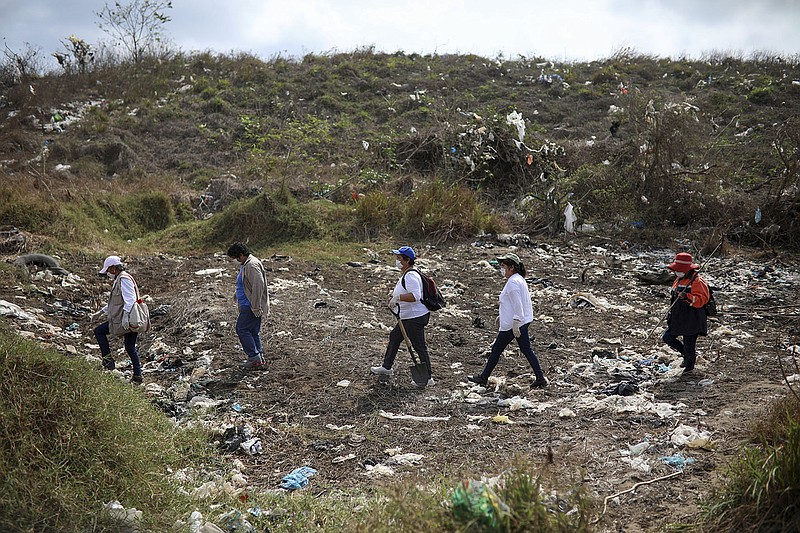MEXICO CITY -- The mainly female volunteers who fan out across Mexico to hunt for the bodies of slain relatives are themselves increasingly being killed, putting to the test the government's promise to help them in their quest for a final shred of justice: a chance to mourn.
Those who carry on the effort tell stories of long getting threats and being watched -- presumably by the same people who killed their sons, brothers and husbands.
But now threats have given way to bullets in the heads of searchers who have proved far better than the authorities at ferreting out the clandestine burial and burning pits that number in the thousands. Two searchers have been slain in the past two months.
Aranza Ramos had spent over a year searching for her husband, Bryan Celaya Alvarado, after he vanished Dec. 6, 2020. He became one of Mexico's 87,855 "disappeared" people. Most are thought to have been killed by drug cartels, their bodies dumped into shallow graves or burned.
Searchers have learned over the past decade, since the height of Mexico's 2006-12 drug war, that the gangs often use the same places over and over again, creating grisly killing fields.
It was at one such field, known as Ejido Ortiz, in the northern border state of Sonora, where Ramos had been helping search July 15 -- the day she herself was killed.
"In Ejido Ortiz, several clandestine crematoriums have been found, some still smoking and burning when they were found," Ramos' search group said in a statement. "This ejido [collective farm plot] is an active extermination site."
Searchers say they get nervous when the burials they happen on are too fresh. It means the killers may still be around and using the site.
After a day of searching -- the volunteers plunge metal rods into the soil to release the telltale odor of death -- Ramos returned to her home near the city of Guaymas. Just before midnight, she was abducted. The killers drove her a short distance and dumped her bullet-riddled body on the roadside.
Cecilia Duarte, who has spent three years working with the group Searchers for Peace, attended meetings with Ramos in the week before she was killed. Duarte, who found the body of her own son and is now searching for a nephew, said Ramos always tried to play it safe.
"She tried not to stand out, she wasn't a spokeswoman," said Duarte. Indeed, The Associated Press had tried to contact her two months before she was killed, but she did not answer messages.
"Aranza posted a message the week before she died, saying she was searching for her husband, not for the suspects," Duarte recalled.
There are three basic rules that Mexico's volunteer search groups follow:
• Human remains aren't referred to as corpses or bodies. The searchers call them "treasures," because to grieving families they are precious.
• Searchers usually call law enforcement officials when they think they've found a burial, mostly because authorities often refuse to conduct the slow but critical DNA testing unless the remains are professionally exhumed.
• Searches are not conducted to find perpetrators, only to find loved ones.
It is the last rule that volunteers hoped would keep them safe from retaliation.
"As searchers, we are not seeking to find out who is guilty. We are searching for treasures," said Patricia "Ceci" Flores, founder of Searching Mothers of Sonora.
For a long time, it has meant that searchers, and the police who often accompany them, focus on finding graves and identifying remains -- not collecting evidence of how they died or who killed them. Search groups sometimes even get anonymous tips about where bodies are buried, knowledge probably available only to the killers or their accomplices.
But that long-standing arrangement appears to have broken down.
The day after Ramos was killed, Flores received a phone threat. "I got a call saying, 'You're going to be next,'" Flores said. Since then, police have assigned a patrol car to stand guard outside her home in Hermosillo.
Sonora state officials have agreed to provide security for searchers deemed to be in danger. The state also agreed to assign excavation teams to potential burial sites found by searchers within three to five days. But officials seem more interested in damage control. They got the searchers to agree not to take photos of burial sites.
President Andres Manuel Lopez Obrador gave this statement when asked about the killing of Ramos. "We are going to continue to protect all women. We condemn these crimes."
But Ramos was not the first. On May 30, a volunteer search activist, Javier Barajas Pina, was gunned down in the state of Guanajuato, Mexico's most violent.
And two journalists have been killed in Sonora in the space of about two months; on Thursday, reporter Ricardo Lopez was shot to death in a parking lot in Guaymas, the same township where Ramos was killed.
Altogether, 68 human-rights and environmental activists have been killed since Lopez Obrador took office.
